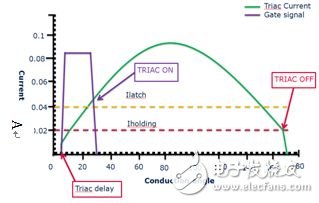
Privacy statement: Your privacy is very important to Us. Our company promises not to disclose your personal information to any external company with out your explicit permission.
 Mr. John chang
Mr. John changThere are three main dimming methods: analog dimming, PWM dimming, and thyristor dimming. The use of thyristor dimming for LED replacement lamp dimming, the existing dimmer circuit can be unchanged, so the dimming method is generally optimistic, so there is an AC-DC control chip suitable for thyristor dimming. Infineon's ICL8002G LED driver chip supports TRIAC dimming and features single-stage PFC and primary measurement control.
The principle of thyristor dimming
The potentiometer RV2 adjusts the phase angle of the thyristor (TRIAC). When VC3 exceeds the breakdown voltage of the DIAC, the thyristor turns on. When the thyristor current drops below its holding current (Iholding) (see Figure 2 below), the TRIAC turns off and must wait until C3 is recharged in the next half cycle before turning it back on. The voltage and current in the filament of the bulb are closely related to the phase angle of the dimming signal, and the phase angle varies from 0 degrees (nearly 0 degrees) to 180 degrees (depending on the dimmer).
LED dimming problems
In order for the LED to be dimmable, its power supply must be able to detect the variable phase angle output of the thyristor controller to adjust the current flowing to the LED. It is very difficult to do this while maintaining the dimmer's normal operation, which often leads to poor performance. Problems can be manifested as problems such as flicker and audio noise. These undesirable phenomena are usually caused by factors such as false triggering or premature shutdown of the thyristor. The root cause of false triggering is current oscillations when the thyristor is turned on. Figure 3 illustrates this effect graphically.

Figure 2. Operating conditions for thyristor conduction

Figure 3 SCR current (thyristor is triggered multiple times, but can not maintain conduction)
When the thyristor is turned on, the AC mains voltage is applied almost instantaneously to the LC input filter of the LED lamp power supply. A voltage step applied to the inductor can cause oscillation. If the dimmer current is below the thyristor hold current during oscillation, the thyristor will stop conducting. The thyristor trigger circuit charges and then turns on the thyristor again. This irregular multiple thyristor restart (Figure 3) allows the LED driver to generate audio noise or LED flicker. Designing a simpler EMI filter helps reduce such unwanted oscillations. For excellent dimming, the input EMI filter inductor and capacitor must be as small as possible.
For thyristors, the holding current required to maintain conduction is typically between 8 mA and 75 mA. Incandescent lamps are easier to maintain at this current level, but for LED lamps that consume only 10% of the equivalent incandescent lamp, this current can be reduced below the thyristor holding current, causing the thyristor to turn off prematurely. This will cause flicker or limit the dimming range.
August 12, 2024
(Fuzhou Xie Telai Lighting Co., Ltd., Fuzhou 350014) Abstract: LED refers to light-emitting diodes, LEDs have inorganic light-emitting diodes (ILEDs), organic light-emitting diodes (OLEDs), and ILEDs...
Among the family of electronic components, there is an element that allows only current to flow in a single direction and has two electrodes, called a diode. English: Diode Diodes are the cornerstone...
Probe current voltage pin 420*4450 head diameter 5.0 over current current and voltage pin Single chip microcomputer STM32L151CCU6 Mobile phone crystal 3.2*2.5mm 3225 26M (26.000MHZ) 7.5PF 10PPM 20PPM...
Author: Wu Guangmin The thyristor dimming LED power supply technology is an important technical bottleneck for LED lighting to replace incandescent lamps in the future. At present, major...
Email to this supplier
August 12, 2024
December 30, 2020
December 16, 2020

Privacy statement: Your privacy is very important to Us. Our company promises not to disclose your personal information to any external company with out your explicit permission.

Fill in more information so that we can get in touch with you faster
Privacy statement: Your privacy is very important to Us. Our company promises not to disclose your personal information to any external company with out your explicit permission.